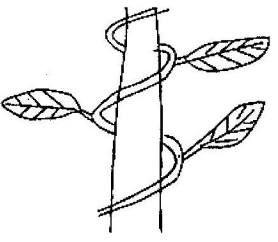- State one structural and one functional differences between motor and sensory neurons
Structural differences
Functional differences ( 2 marks) - The table below shows two mammalian hormones. For each hormone, state the site of production and its function in the body.
Hormone Site of production Function Oestrogen Aldosterone - The diagram below represents a motor neurone.
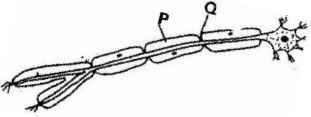
- With an arrow, indicate on the diagram the direction of the impulse through the neurone ( 1 mark)
- State the functions of parts labeled P and Q ( 2 marks)
-
- How are structures of the human eye adapted to their functions (14 marks)
- State three defects of the eye and how each can be corrected (6 marks)
- State the changes that occur in a nerve axon to produce an action potential (3 marks)
- In an accident a victim suffered brain injury. Consequently he had loss of memory. Which part of the brain was damaged? ( 1 mark)
- The diagram below shows surface view of a human brain
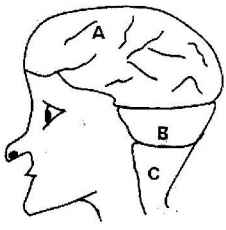
- Name the parts labeled B and C ( 2 marks)
- State three functions of the part labeled A ( 3 marks)
- State what would happen if the part labeled B was damaged. ( 1 mark)
- What is the function of the following cells in the retina of the human eye? (2 marks)
- Cones
- Rods
-
- State the functions of the following parts of the mammalian ear
- Tympanic membrane ( 3 marks)
- Eustachian tube ( 1 mark)
- Ear ossicles ( 2 marks)
- Describe how semi- circular canals perform their functions ( 2 marks)
- State the functions of the following parts of the mammalian ear
- State the importance of tactic response among some members of Kingdom Protoctista? ( 1 mark)
-
- What name is given to response to contact with surface exhibited by tendrils and climbing stems in plants? ( 1 mark)
- State three biological importances of tropisms to plants (3 marks)
- The diagram below represents a reflex arc in human
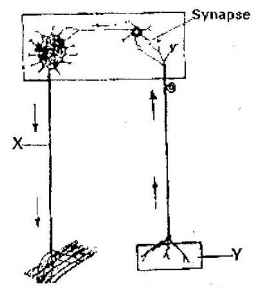
- Name the parts labeled X and Y ( 2 marks)
X __________________________
Y __________________________ - Name the substance that is responsible for the transmission of an impulse across the synapse ( 1 mark)
- Name the parts labeled X and Y ( 2 marks)
-
- State the function of the ciliary muscles in the human eye. (1 mark)
- State two functional differences between the rods and cones in the human eye (2 marks)
- State the function of each of the following parts of human ear ( 4 marks)
- Ear ossicles
- Cochlea
- Semi- circular canals
- Eustachian tube
-
- Where in the human body are relay neurons found? ( 1 mark)
- The diagram below represents a neurone
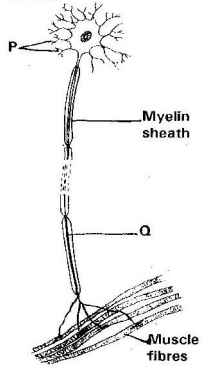
- Name the neurone ( 1 mark)
- Name the parts labeled P and Q ( 2 marks)
-
- Name the hormone that is responsible for apical dominance (1 mark)
- What is thigmotropism? (1 mark)
- Describe the structure and functions of the various parts of the human ear (20 marks)
- Nocturnal animals such as the owl are capable of seeing fairly well at night
What two retinal adaptations have made this possible? (2 marks) - State two functions of the human ear? (2 marks)
- State four differences between co- ordination of the human eye’s internal response to light and that of tropic movement of the flowering plant in response to light. (4 marks)
- The figure below shows a stem of a plant growing round a tree trunk
- What is the name of the response, which causes the twisted growth? (1 mark)
- Explain how the twisting process is accomplished (2 marks)
- Identify the state of leaves if the plant is autotrophic (2 marks)
- Euglena is positively phototactic. Of what biological significance is this characteristics? (1 mark)
- State the function of acetylcholine (2 marks)
- Where in the human body is the relay neurone located? ( 1 mark)
- State three effects of nicotine to human health (3 marks)
- state the part of the eye involved in
- Colour vision
- Maintaining shape of the eyeball
- Change in diameter of the lens












Answers
- Structural difference - the cell body in motor neurone is terminal (at the end) and inside the central is nervous system. While the cell body in sensory neuron is not terminal but has axon on both end i.e. bipolar.
Functional differences – motor neurone carries impulses from CNS to the effectors i.e. muscles, while sensory neurons carry impulse for receptor to CNS. -
Hormone Site of production Function Oestrogen Ovary Initiate and control development of secondary sexual
characteristicsAldosterone Aldernal gland Mineral reabsorption -
-
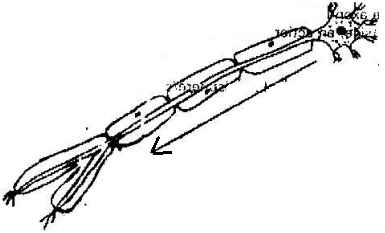
- P- Protection/ insulation
Q- Impulses transmitted/depolarization is faster.
-
-
-
Adaptation Function Conjunctiva - An epithelium colourless Protects eyeball Cornea: Transparent/curved Allow light/ refract light entering the eye Aqueous/vitreous: clear Allow light to pass through/ refract light.
Maintain the shape of the eyeIris. Opaque and contractile Controls light intensity/amount of light
entering the eye.Ciliary muscle/ body contractile Control curvature of lens, secretes humour Suspensory ligaments: are fibrous Hold lens in position Lens is transparent; lens is biconvex To allow light to go though/to refract light/
to focus light.Retina- contain light sensitive cells Where an image is formed which perceive
light.Cones: contain pigments For colour vision/ bright light/ light of high
intensityRods contain pigments For dim light vision Forea centralis: High concentration of
conesFor accurate vision Choroid: Layer has blood vessels For nutrition and pigments.
Reduce light reflection and absorb stray
lightSclera- Tough/ non elastic or fibrous Gives eye shape and protects Optic nerve Contain sensory neurones for transmitting
impulses from retina to brain -
Defect Correct Myopia/ short sightedness Biconcave/diverging lenses Hypermetropia/long sightedness Biconvex/ converging lenses Astigmation Use of cylindrical lenses with combined
curvature
-
- When an impulse passes along the axon, the membrane of the axon becomes depolarized to sodium ions to diffuse into the axon; the inside of the axon becomes positively charged relative to the outside, an action potential is generated.
- Cerebrum/ cerebral hemisphere/ cerebral cortex
-
- B- Cerebellum
C- Medulla oblongata - - Control locomotion
- Control voluntary movement
- Vision/ hearing/ smell/ taste
- Intelligence/ memory
- Personality speech
- Mediates cranial co-ordination - Loss of muscle coordination/ balance
- B- Cerebellum
-
- Cones- Discrimination of colour/ sensitive to high light intensity / bright light.
- Rods- Dim light vision/ low light intensity
-
-
- -Receive sound waves
-Transforms sound waves into vibrations
-Transmit vibration to the ear ossicles - Equalizes the air pressure in the middle ear to that in the outer ear.
- Amplify/ transmit vibrations from the lympanic membrane in the inner ear.
- -Receive sound waves
- There are three semi- circular canals arranged in a plane at right angles to each other. At the end of each canal is a swelling called ampulla which contains receptors.
Movement of the beat cause movement of the fluid in at least one canal/ the fluid movement deflect the coperta and stimulate the receptors/sensory hairs. Nerve impulses are transmitted to the brain by the auditory nerve.
-
- The organisms move towards light so as to absorb it for photosynthesis.
-
- Thigmotropsm
- -That part of plants is offered support
-The leaves become more exposed to sunlight increasing photosynthesis.
-Flowers become exposed to pollinating agents.
-
- X- Motor neurone
Y- Receptor - Acetylcholine
- X- Motor neurone
-
- Alter the shape of the lens during accommodation
- - Rods- sensitive to dim light
- Cannot distinguish colour
- Cones- Sensitive to colour
- Enhance high clarity of vision
-
- Ear ossicles Magnify sound wave vibrations from the ear drum
- Cochlea Receives sound vibrations from the oval window and transmits into the auditory nerve.
- Semi- circular canals Structures that help maintain body balance
- Eustachian tube Enhance equalizing of pressure between outer and the middle ear.
-
- In the central nervous system (spinal cord)
-
- Motor neurone
- P – Dendrites
Q- Axoplasm (Axon)
- Insulates the axon
-
- Auxin
- Growth response due to touch of a part of a plant e.g. tendrils
- The ear is an organ involved in perceiving sound and maintaining body balance and posture. It is made of the following sections.
Outer ear that is composed of
- Pinna- That is funnel shaped structures made of skin and cartilage. It receives sound waves and directs them to the ear tube.
- External /auditory meatus- That is a canal lined with hair and wax. It allows passage of sound waves to the middle ear. The hairs and wax trap dust particles that enter the ear.
- Tympanic membrane that is a thin flexible sheet-like structure receives sound waves and passes the vibration to the ossicles.
Middle ear that is composed of:
- Tiny bones known as ossicle. They are stapes, anvil and incus. They amplify vibration from the tympanic membrane.
- Eustachian tube that connects the ear to the nasal cavity. It balances pressure on both sides of the tympanic membrane.
- Oral window that is a thin flexible membrane that opens into the inner ear. it receives vibrations from the ossicles and passes them to the inner ear.
Inner ear that is composed of:
- Vestibular apparatus that are the semi circular canals, utricles and the saccules. They help in maintenance of body balance and posture.
- Cochlea that is a coiled structure that has sensory cells for hearing. It is connected to the auditory nerve that is involved in transmission of sounds to the brain. - - Presence of rods having rhodopsin pigment that is sensitive to dim light.
- Rods are more sensitive to motion and easily notes movement from the cornea of the eye.
- More than 120 million rods present on the retina. - Perceive sound waves.
Maintain body balance and posture. -
Response of human eye Response of flowering plant • Quick response
• Does not result to growth
• Mediated by nerve impulses and brain
• The response is not permanent• Slow response
• Results to growth
• Mediated by growth hormones (auxins)
• Response is more permanent -
- Thigmotropism
- Auxins on the stem are sensitive to touch. They migrate to opposite side.
Growth is more on the touched side. This causes bending. - Have more chlorophyll to trap sunlight
- Have stomata for entry of carbon dioxide.
- Thin and transparent cuticle to allow entry of light into the photosynthetic cells
- Presence of veins for transportation of raw materials to the leaf or food for the leaf.
- Euglena have chlorophyll and are autotropic. They move towards light source (positive phototactic) to absorb sunlight for photosynthesis.
- Acetylcholine is a chemical substance present at the synaptic knob. When a nerve impulse reaches the synapsis, acetylcholine forms in vesicles moving to the membrane.
- In the spinal chord.
- - Tar is deposited on parts of the respiratory tract causing cancer.
- Hardening the blood vessels and can cause heart attack.
- Irritation of the respiratory tract resulting to frequent coughing.
- Smoke can cause air pollution. -
- Cones on retina.
- Vitreous humour.
- Suspensory ligaments.
Join our whatsapp group for latest updates
Tap Here to Download for 50/-
Get on WhatsApp for 50/-
Download Reception, Response and Co-ordination Questions and Answers - Biology Form 4 Topical Revision.
Tap Here to Download for 50/-
Get on WhatsApp for 50/-
Why download?
- ✔ To read offline at any time.
- ✔ To Print at your convenience
- ✔ Share Easily with Friends / Students

